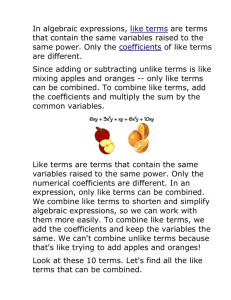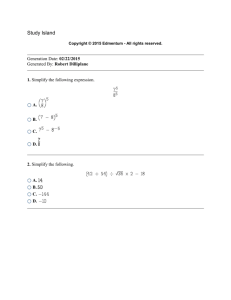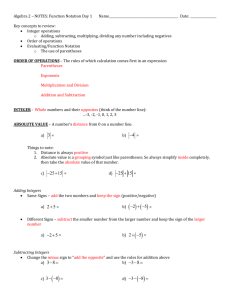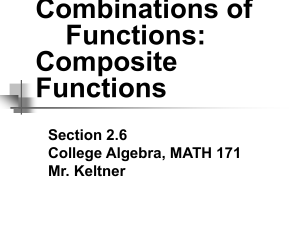Evaluating and Simplifying Expressions
advertisement
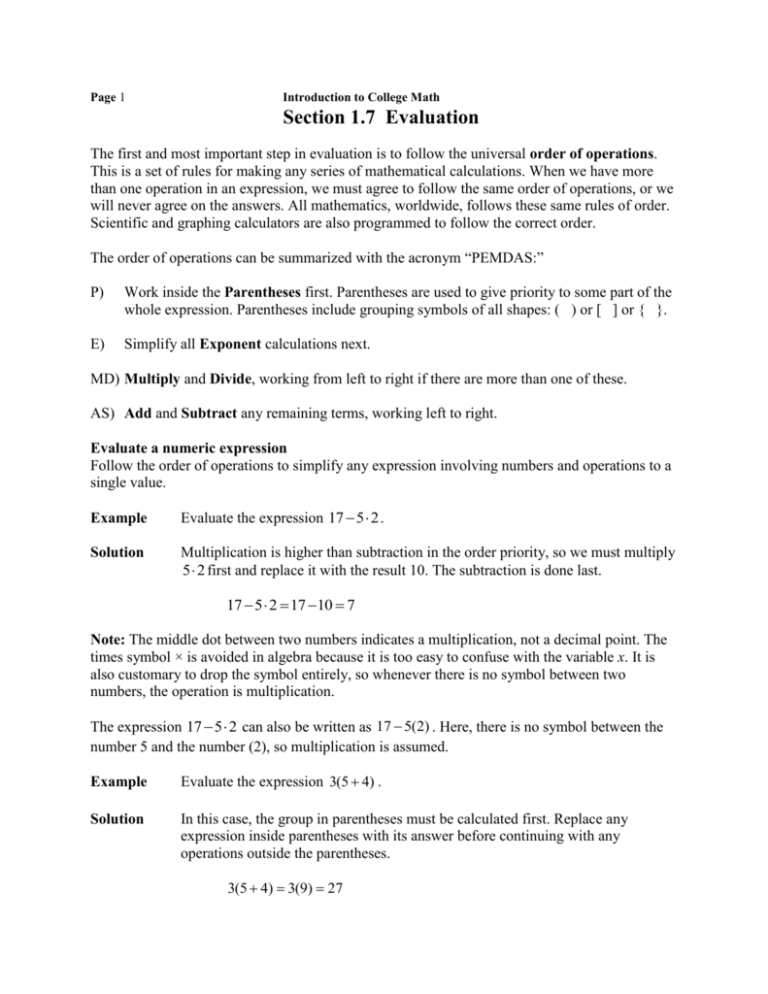
Page 1
Introduction to College Math
Section 1.7 Evaluation
The first and most important step in evaluation is to follow the universal order of operations.
This is a set of rules for making any series of mathematical calculations. When we have more
than one operation in an expression, we must agree to follow the same order of operations, or we
will never agree on the answers. All mathematics, worldwide, follows these same rules of order.
Scientific and graphing calculators are also programmed to follow the correct order.
The order of operations can be summarized with the acronym “PEMDAS:”
P)
Work inside the Parentheses first. Parentheses are used to give priority to some part of the
whole expression. Parentheses include grouping symbols of all shapes: ( ) or [ ] or { }.
E)
Simplify all Exponent calculations next.
MD) Multiply and Divide, working from left to right if there are more than one of these.
AS) Add and Subtract any remaining terms, working left to right.
Evaluate a numeric expression
Follow the order of operations to simplify any expression involving numbers and operations to a
single value.
Example
Evaluate the expression 17 5 2 .
Solution
Multiplication is higher than subtraction in the order priority, so we must multiply
5 2 first and replace it with the result 10. The subtraction is done last.
17 5 2 17 10 7
Note: The middle dot between two numbers indicates a multiplication, not a decimal point. The
times symbol × is avoided in algebra because it is too easy to confuse with the variable x. It is
also customary to drop the symbol entirely, so whenever there is no symbol between two
numbers, the operation is multiplication.
The expression 17 5 2 can also be written as 17 5(2) . Here, there is no symbol between the
number 5 and the number (2), so multiplication is assumed.
Example
Evaluate the expression 3(5 4) .
Solution
In this case, the group in parentheses must be calculated first. Replace any
expression inside parentheses with its answer before continuing with any
operations outside the parentheses.
3(5 4) 3(9) 27
Page 2
Introduction to College Math
Example
Evaluate the expression 5 11(8 5) 16 .
Solution
Again, the group in parentheses must be calculated first. Then do the
multiplication, and finish with the addition and subtraction.
5 11(8 5) 16
5 11(3) 16
5 33 16
38 16
22
Note: Addition and subtraction will always be the last operations performed, unless they are
grouped inside parentheses.
Example
Evaluate the expression 8 (5 2)2 .
Solution
Again, the group in parentheses must be calculated first.
8 (5 2)2 8 (3)2
The raised “2” here is an exponent. Exponents are a short-hand for repeated
multiplications. (3)2 means to multiply two copies of the base number 3:
(3)(3) = 9. Replace the exponent calculation (3)2 with the result 9, and then
continue following PEMDAS:
8 (5 2) 2
8 (3) 2
89
17
Page 3
Introduction to College Math
Evaluate a variable expression
With a variable expression, individual variables may be assigned specific values. In this case,
replace each letter with the known value, and then follow the order of operations to simplify the
remaining numeric expression to a single value.
Example
Evaluate the expression a 2 2b when a = 5 and b = 3.
Solution
Think of the variables as place holders. The best way to do this is to replace each
letter with empty parentheses. This makes room for the actual value, which then
fills in the parentheses. After filling in the given values for a and b, the exponent
calculation has the highest priority, followed by the multiplication, and then the
subtraction last.
a 2 2b
( ) 2 2( )
(5) 2 2(3)
25 2(3)
25 6
19
Example
Evaluate the expression y 2 2( x 7) when x = 4 and y = 9.
Solution
Replace each variable with the known value and then follow PEMDAS.
y 2 2( x 7)
( ) 2 2(( ) 7)
(9) 2 2(4 7)
92 2(11)
81 2(11)
81 22
59
Page 4
Introduction to College Math
Simplifying Expressions
To simplify variable expressions, we need to learn what happens with different operations.
Naturally, addition has a different effect than multiplication. In this section, we will look at some
basic simplification techniques involving addition, subtraction, and multiplication in variable
expressions.
Addition and subtraction of variable terms
Even if you have never worked with variables, you are probably already familiar with combining
like terms. For example, the sum of 4 boxes and 5 boxes is 9 boxes. You simply add (4 + 5 = 9)
and keep the “boxes” as the like units. Now let x be a variable that represents one box. The
calculation becomes 4x + 5x = 9x. In words, you could say “4 x’s and 5 x’s make 9 x’s. This
works for any variable: 7a – 20a = – 13a, and – 2b – 3b = – 5b.
The number in front of any variable is called the coefficient of the variable. The coefficient is the
number attached a variable term by multiplication. To add or subtract variable terms, we
combine the coefficients and keep the same variable (these are called like terms).
Note that we usually do not write a coefficient of 1, so x alone really means 1x. Thus 9x + x =
10x. This is consistent with our English language, where we might refer to “a box” without
emphasizing that we specifically mean “one box.”
If two terms have different variable parts, then we cannot simplify the expression. For example,
the expression 12b + 4w has no simpler form. How else could you write “12 bananas and 4
watermelons” without losing information? Also note that a constant term (one with no variable)
is different from any variable term. If terms have different variables, leave them alone. If they
have the same variable, you may combine the coefficients.
Examples
6y + 10y simplifies to 16y
3t – 21t simplifies to –18t
62w – 70w simplifies to –8w
–20 + 4x – 3 simplifies to 4x – 23
8x – 3 + 7x + 9 simplifies to (8x + 7x) + (– 3 + 9) = 15x + 6
9m + 3p – 4m + 12 simplifies to 5m + 3p + 12 (combine only the two m terms)
Variable terms must also have the same exponent to qualify as like terms. 3x2 and 5x2 are like
terms and may be added: 3x2 + 5x2 = 8x2.
Note: The exponent is never changed by an addition or subtraction operation.
Example
Simplify 30t 2 7t – 8 –12t 2 3t 5 .
Page 5
Solution
Introduction to College Math
Group the like variable terms.
30t 2 7t – 8 –12t 2 3t 5
30t 2 –12t 2 7t 3t –8 5
18t 2 10t 3
Multiplication using the distributive property
The distributive property of real numbers shows how multiplication and addition/subtraction
interact. For example, we can see that 4(2 + 3) = 4(5) = 20 if we simply follow the order of
operations. On the other hand, we can multiply first provided we multiply through to each term
inside the parentheses: 4(2 + 3) = 4(2) + 4(3) = 8 + 12, which is 20 again. This property always
works, no matter what the numbers are.
In general, we can write the distributive property as a(b + c) = ab + bc for all real numbers a, b,
and c. In other words, when we have a multiplier in front of a parentheses group, we can choose
to simplify and remove the parentheses provided that we multiply through to each term inside the
parentheses. This is especially useful when variables are involved, because we may have no
other way to simplify an expression with parentheses.
Example
Examples
2(x + 3) = 2(x) + 2(3) = 2x + 6
5(p – 9) = 5(p) – 5(9) = 5p – 45
3(4c – 2) = 3(4c) – 3(2) = 12c – 6
7(2x + 1) = 7(2x) + 7(1) = 14x + 7
With a negative coefficient in front of the parentheses group, all of the signs inside get changed.
Example
Simplify 2( f 6) .
Solution
Multiply both terms inside the parentheses by –2.
2( f 6)
–2 f – 2 6
–2 f –12
Note: Multiplying two numbers with the same sign (both positive or both negative) always has a
positive result. Multiplying two numbers with different signs (one positive and one negative)
always has a negative result.
Example
Simplify 4(9v 2) .
Solution
Multiply both terms inside the parentheses by –4.
Page 6
Introduction to College Math
4(9v 2)
–4 9v – 4 –2
–36v 8
With more terms inside the parentheses, multiply the coefficient by every term:
Example
Simplify –6 2 x – 5 y –10 .
Solution
Multiply all three terms inside the parentheses by –6.
–6 2 x – 5 y –10
–6 2 x – 6 –5 y – 6 –10
–12 x 30 y 60
For expressions with two or more parentheses groups, simplify first by multiplying each group
using the Distributive Property, and then combine any like terms from the two groups.
Example
Simplify 2(4 x 9) 3(2 x 1) .
Solution
Distribute the coefficient through each group first.
2(4 x 9) 3(2 x 1)
2(4 x) 2(9) 3(2 x) 3(1)
8x 18 6 x 3
14 x 21
Example
Simplify 2(m 7) 5(2m 3) .
Solution
Note that the negative coefficient starting the second group changes signs on both
of the following terms.
2(m 7) 5(2m 3)
2(m) 2(7) 5(2m) 5( 3)
2m 14 10m 15
8m 1



